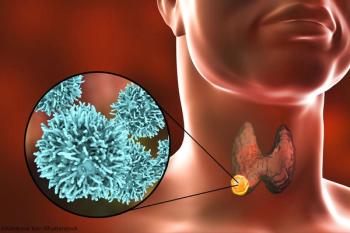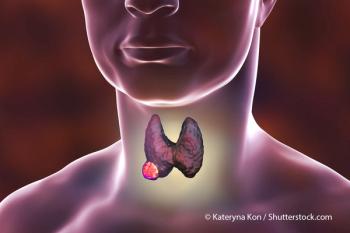
Effect of Shorter Dose Interruption in Radioiodine-Refractory Differentiated Thyroid Cancer
Researchers evaluated the impact of dose interruption on survival for lenvatinib vs placebo in patients with progressive differentiated thyroid cancer.
Lenvatinib significantly improved progression-free survival (PFS) compared with placebo, regardless of the length of dose interruption, in patients with radioiodine-refractory differentiated thyroid cancer. However, patients with shorter dose interruptions experienced longer PFS than did those with lengthier interruptions. These are among the findings of the phase III SELECT study, which were recently
“These data help provide insight into how to optimally dose lenvatinib to provide the most benefit possible to every patient,” said
“I think we also can learn from this kind of post-hoc analysis, and build similar analyses of optimal dosing into future clinical trial design. This is especially important in the era of oral cancer therapies, [which are] now becoming more and more common,” noted Wirth.
The current exploratory post-hoc analysis examined the effects of dose interruption on lenvatinib efficacy in patients experiencing grade 3 or intolerable grade 2 adverse events. Lenvatinib-treated patients were split into two groups based on the length of dose interruption. The shorter dose interruption was < 10% of total treatment time, and the longer dose interruption was ≥ 10%.
At a median follow-up of 17.1 months, the median PFS in the shorter dose-interruption group was not attained. The median PFS for the longer dose-interruption group, however, was 12.8 months (95% CI, 9.3–16.5). Compared with placebo, the hazard ratio for PFS was 0.14 in the shorter dose-interruption group (95% CI, 0.09–0.20) and 0.31 for the longer dose-interruption groups (95% CI, 0.22–0.43). Dose interruption was significantly correlated with lenvatinib efficacy, per multivariate modeling with adjustment for patient characteristics.
Patients treated with lenvatinib, however, presented with more adverse events (AEs), which were managed with dose modifications such as dose interruption.
“In my experience in treating patients with lenvatinib, I have found that patients’ side effects usually improve quickly, after just a couple of days,” said Wirth. “So rather than waiting 2 weeks to restart treatment, we should restart as soon as we can.”
Other experts have hypothesized that longer interruption may be associated with disease progression or decreased efficacy.
The study authors noted that during dose interruption, some patients could exhibit disease progression, which is likely unrelated to lenvatinib resistance. Although SELECT did not include study treatment beyond disease progression-with treatment for such patients discontinued-some patients with disease progression during a dose interruption may benefit from resuming lenvatinib therapy following abatement of adverse events. This possible benefit is akin to what has been shown in recent research involving patients with metastatic renal cell carcinoma.
Appropriate, responsive, and robust management of lenvatinib toxicities should be used to limit dose interruptions and therefore maximize the potential clinical efficacy of lenvatinib in patients with radioiodine-refractory differentiated thyroid cancer, the authors concluded.
Wirth noted that this study is one of various further analyses conducted by the SELECT researchers. “The SELECT team has done several other ‘deep dives’ into the data set to mine information on critical questions, including analysis of outcomes with elderly patients on lenvatinib, and the impact of treatment-emergent hypertension on outcomes,” she said.
“These additional analyses have really helped provide information on how we can best take advantage of the drug in treating patients with iodine-refractory differentiated thyroid cancer,” Wirth commented.
Newsletter
Stay up to date on recent advances in the multidisciplinary approach to cancer.





















































































